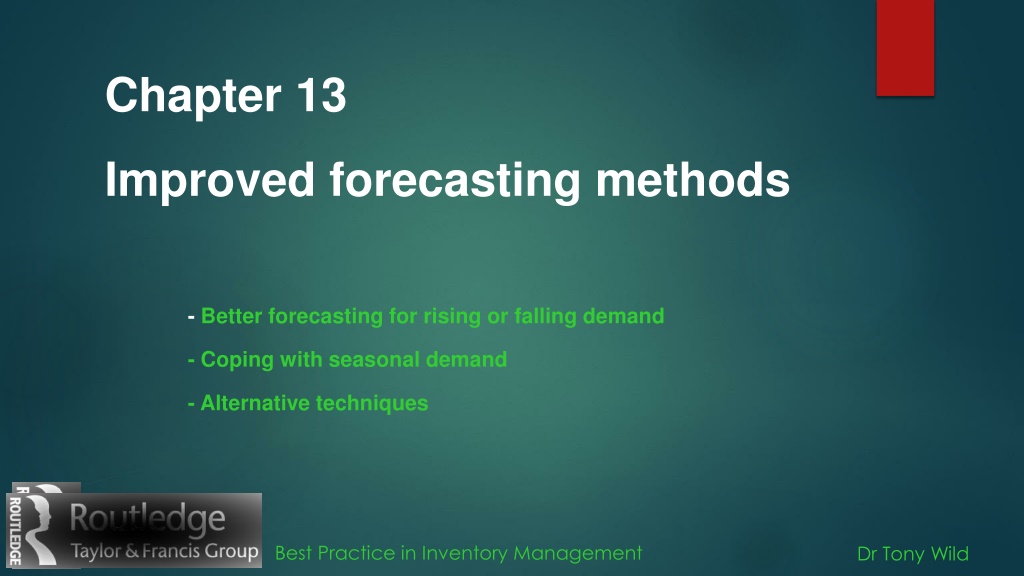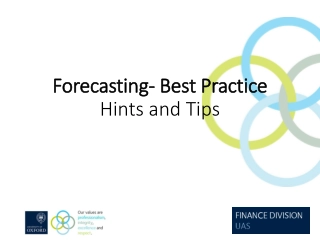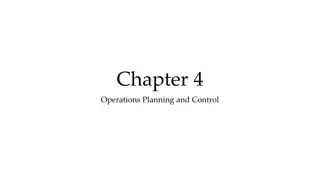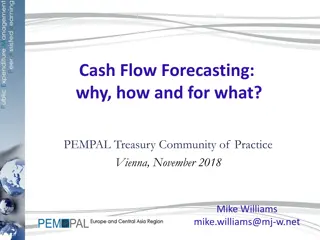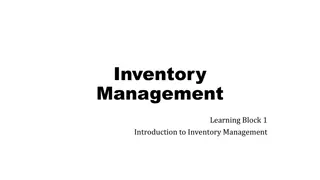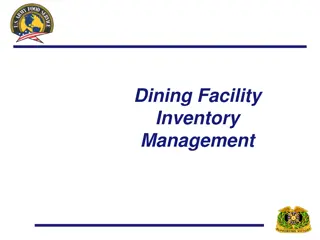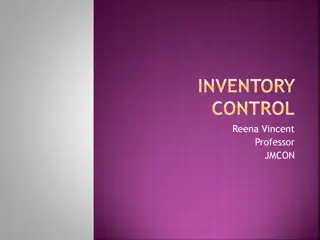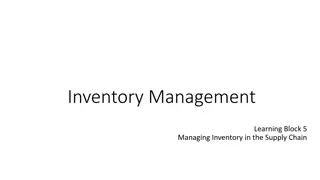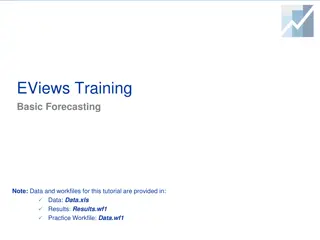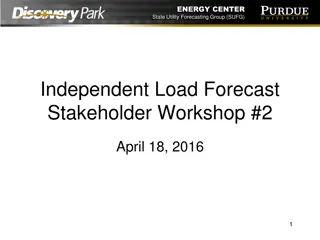Enhancing Forecasting Techniques for Inventory Management
Explore improved forecasting methods for better anticipating rising or falling demand, handling seasonal demand fluctuations, and utilizing alternative techniques in inventory management. Dr. Tony Wild presents insightful strategies and figures showcasing double exponential smoothing, trend forecasting, and the impact of sudden demand changes.
Download Presentation

Please find below an Image/Link to download the presentation.
The content on the website is provided AS IS for your information and personal use only. It may not be sold, licensed, or shared on other websites without obtaining consent from the author.If you encounter any issues during the download, it is possible that the publisher has removed the file from their server.
You are allowed to download the files provided on this website for personal or commercial use, subject to the condition that they are used lawfully. All files are the property of their respective owners.
The content on the website is provided AS IS for your information and personal use only. It may not be sold, licensed, or shared on other websites without obtaining consent from the author.
E N D
Presentation Transcript
Chapter 13 Improved forecasting methods - Better forecasting for rising or falling demand - Coping with seasonal demand - Alternative techniques Best Practice in Inventory Management Dr Tony Wild
Figure 13.1 Forecasting Trend Double Exponential Smoothing 140 120 Forecasts 100 80 60 Demand alpha = 0.4 40 alpha = 0.2 20 Exponential Smoothing alpha = 0.4 0 1 2 3 4 5 6 7 8 9 10 11 12 13 Best Practice in Inventory Management Best Practice in Inventory Management Dr Tony Wild Dr Tony Wild
Figure 13.2 Double exponential model Y=bx + d Y Demand b a Time Periods x Best Practice in Inventory Management Best Practice in Inventory Management Dr Tony Wild Dr Tony Wild
Figure 13.3 Double exponential smoothing process Best Practice in Inventory Management Best Practice in Inventory Management Dr Tony Wild Dr Tony Wild
Figure 13.4 Double Exponential Calculations Demand Level recalculated, d Trend Forecast for next week, Dt- Customer Demand Week Error Recalculated, t 1 9 61.34 73.66 63.88 62.42 61.23 52.70 62.74 71.65 62.76 2.57 3.65 2.16 1.76 1.43 0.32 1.40 2.23 1.00 63.91 77.31 66.04 64.18 62.66 53.02 64.14 73.88 63.76 10 11 12 13 14 15 16 17 91 40 56 56 35 80 85 43 -27.1 37.3 10.0 8.2 27.7 -27.0 -20.9 30.9 Best Practice in Inventory Management Best Practice in Inventory Management Dr Tony Wild Dr Tony Wild
Figure 13.5 Double Exponential Smoothing Forecasts 140 120 100 Forecasts Demand 80 Demand 60 alpha = 0.4 40 alpha = 0.2 20 Exponential Smoothing alpha = 0.4 0 1 2 3 4 5 6 7 8 9 10 11 12 13 Weeks Best Practice in Inventory Management Best Practice in Inventory Management Dr Tony Wild Dr Tony Wild
Figure 13.6 Effects of Sudden Demand Changes 60 3 3 50 40 2 2 30 Forecasts 20 1 1 alpha = 0.3 10 Demand 0 1 2 3 4 5 6 7 8 9 10 11 12 13 14 15 16 Best Practice in Inventory Management Best Practice in Inventory Management Dr Tony Wild Dr Tony Wild
Seasonal Demand History 300 250 200 Demand 150 100 50 Year -1 0 Year -2 1 2 3 4 Year -3 5 6 7 8 9 10 11 12 Month Best Practice in Inventory Management Dr Tony Wild
Fig 13.7 Creating the Base Series Demand History Year 1 40 20 80 200 150 210 140 70 30 10 70 120 95 Seasonal Factors Year 1 Year 2 0.421 0.600 0.211 0.200 0.842 0.700 2.105 1.500 1.579 2.300 2.211 2.400 1.474 1.600 0.737 0.200 0.316 0.300 0.105 0.200 0.737 1.000 1.263 1.000 1 Base Series 0.531 0.264 0.705 1.773 2.055 2.394 1.659 0.503 0.205 0.134 0.738 Month 1 2 3 4 5 6 7 8 9 10 11 12 Total Year 2 60 20 70 150 230 240 160 20 30 20 100 100 100 Year 3 60 40 60 180 240 270 200 60 0 10 50 90 105 Year 3 0.571 0.381 0.571 1.714 2.286 2.571 1.905 0.571 0.000 0.095 0.476 0.857 1 1.040 1 Best Practice in Inventory Management Dr Tony Wild
Figure 13.8 Forecasting with Base Series Equivalent Average Demand New Seasonal Month Base Series from figure 13.7 Forecast Sales Actual Sales Smoothed Average 130 122.87 121.37 117.10 123.06 119.91 Initial Forecast = 1 2 3 4 5 6 7 8 9 10 11 12 68.90 31.95 84.96 207.26 252.27 286.58 50 30 70 260 220 0.53 0.26 0.7 1.77 2.05 2.39 1.66 0.5 0.21 0.13 0.74 1.04 94.3 115.4 100.0 146.9 107.3 Normal Exponential Smoothing alpha = 0.2 Exponential Calculation from Forecast & Equivalent Actual Base Series X New Smoothed Average Actual Sales divided by Base Series Value Calculation Actual Sales Recorded From Historical Base Series Best Practice in Inventory Management Dr Tony Wild
Figure 13.9 Baysian Approach Causes of forecast errors Best Practice in Inventory Management Dr Tony Wild
Figure 13.10 Forecasting Models Forecasting Model Moving Average Application Constraints Static demand level, irregular pattern Usually Unsuitable for major products Oversensitive to outliers Regression Analysis Continuous trend, irregular pattern Exponential Smoothing Variable demand, gradual changing level, and slow moving spares items Seasonal demand, mature products with low variability consistent increasing or decreasing demand, product phase-in and obsolescence Cyclic established demand e.g. commodities General products Good Basic Workhorse Base Series Basis for most seasonal forecasting Apply where variability does not mask trend Double Exponential Smoothing Fourier Analysis Product with long consistent history Mathematics needs developing Baysian Forecasting Fuzzy Logic Sophisticated modelling Not yet available More sophisticated techniques Specific models Improved exponential forecasts with more complex formulae Based on market knowledge, potentially Much history often needed, for longer term forecasting Unreliable due to forecasters bias Best Practice in Inventory Management most accurate Dr Tony Wild
